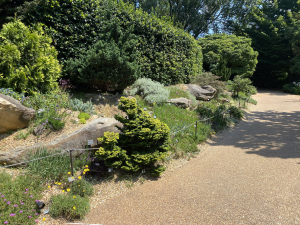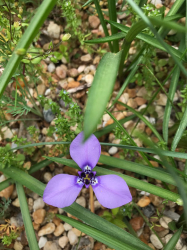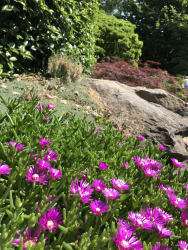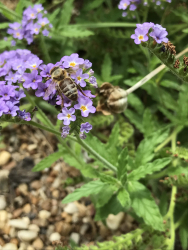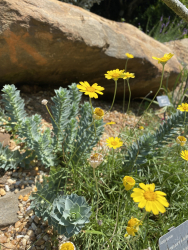I’d love to be able to grow high-altitude alpine plants, but the daily commute from Atlanta to Denver would be too much, and I’d miss my dog. Instead, we’ve expanded the definition of a rock garden to be “gardening among the rocks with unusual dwarf perennials, shrubs, trees, grasses, and bulbs.” At the Atlanta Botanical Garden, we do have a separate garden area for desert southwest cacti and succulents, so yucca and agave have a unique, well-drained, sun-capturing home elsewhere. The plants in this garden also thrive in high heat conditions, drought, wind, direct sun, and extreme temperatures. Besides the huge boulders, the substrate upon construction was probably sand mixed with red clay, with the pea gravel intended to be used as a mulch.
The heat and humidity in Atlanta provide a unique opportunity for plant selection and trial and error. We live in a temperate (USDA Zone 8a) humid subtropical climate with consistently hot, muggy summers and cold winters. For example, in July, the average daily relative humidity is 74%, hitting 88% RH by seven in the morning and averaging a high of 90°F (32°C), typically punctuated with thunderstorms in the afternoon. We average 52 inches (132 cm) of rain annually and one inch (2.54 cm) of snow per year. I almost never water the rock garden, except if I've added a new plant in the middle of the summer (despite my better judgment; I should wait till the fall), or to keep the conifers happy during a drought period.
Over the past thirty years of this garden, plants that were trialed and written off can sometimes re-emerge. Case in point: our one living Alophia drummondii (15 inches/38 cm tall, summer-blooming irid) which I had no hope for after two or three years of babying. I have a special interest in other Iridaceae, partly because they’ve been successful in the rock garden with some care and editing neighboring “bullies.” A few years ago, I found one or two Iris pumila (10 inches/ 25 cm tall, spring-blooming) all but suffocated by some vigorous creeping thyme. After editing out a couple of key patches of the thyme, these irises have become a successful little colony. A similar story followed with Iris douglasiana (12-16 inches/30 – 40 cm, evergreen, spring-blooming) and Herbertia lahue subsp. lahue (4 inches/10 cm tall, spring-blooming). On the other hand, Sisyrinchium sp. (probably S. angustifolium; 8 inches/20 cm tall, blooms May to June) needs no coddling as it reseeds responsibly.
Some plants in our hot and humid rock garden do exceedingly well. I love Delosperma cooperi (4 inches/10 cm tall, summer-blooming), but I frequently find myself peeling huge chunks of it away so we can actually see some rock formations below the sparkly mat. Heliotropium amplexicaule 'Azure Skies' (8-12 inches/20-30 cm tall, summer-blooming) seeds around too well, although it is beautiful in bloom. It also is perennial here, so I get lots of opportunities to prune back or simply edit out this taprooted spreader. I read in a recent NARGS Quarterly about someone’s affinity for Scilla scilloides (15 inches/38 cm tall, midsummer-bloomer). For me, I wish no one had ever introduced it to the garden, as it has become a weed I am always trying to catch up with.
Other perennials that are stalwart throughout the seasons include summer dormant Oxalis brasiliensis (1 inch/2.54 cm tall, winter-bloomer), which really put on a show this winter; Tetraneuris scaposa (1 inch/2.54 cm, summer-blooming); the ever-present sundancer daisy (Hymenoxys acaulis, 7-9 inches/18 – 23 cm tall); and Liatris microcephala (18-24 inches/46-61 cm tall, summer-blooming), with which I use pruning to play with the height and bloom time like you would a chrysanthemum or rudbeckia.
We also have some amazing ephemerals that grace us every year, including various species tulips, Narcissus, Scadoxus multiflorus subsp. katharinae (1 inch/2.54 cm, blooms midsummer), and Rhodophiala bifida (15 inches/38 cm, late summer/early fall bloom) to name just a few.
Our conditions are both limiting and a catalyst for creativity and learning, and it’s my pleasure to hop from rock to rock creating alpine vistas at (effectively) sea level.
Atlanta Botanical Garden’s Rock Garden
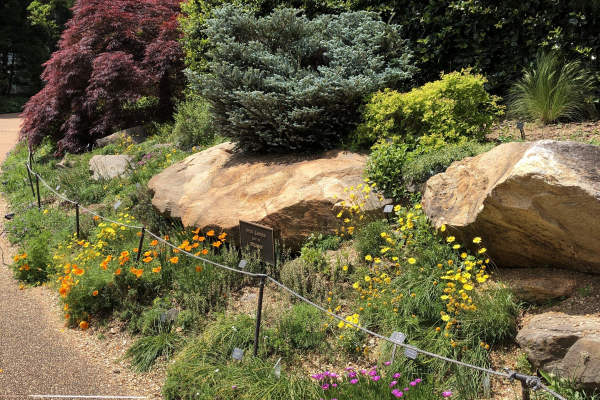
April 1, 2021
ATLANTA BOTANICAL GARDEN has one of the largest public rock gardens in the southeastern US. Our rock garden is about 100 feet (30 m) long and no more than 15 feet (4.6 m) wide, with a 15-30-degree slope. Its gentle curve faces south-southeast and its large boulders came from the construction site of the AT&T Promenade building in Midtown Atlanta back in 1989. Most days you can see me scrambling from rock to rock, taking great pains to avoid causing any mini-landslide of pea gravel down the slope.

